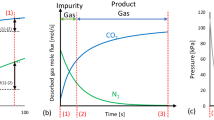Abstract
Heat effects in the pressure swing adsorption (PSA)-n-butane vapor recovery process were investigated at the periodic state by computer simulation. The PSA process utilized a two-bed, four-step, vacuum swing cycle and BAX activated carbon as the adsorbent. The heat effects were manifested by varying the heat transfer coefficient (h) from isothermal to adiabatic, while simultaneously varying the adsorbed phase heat capacity (Cpa) from zero to that of the saturated liquid. In terms of the bed capacity factor (BCF), isothermal operation always resulted in the best performance, whereas adiabatic operation was not the worst; independent of Cpa, the worst performance occurred at an intermediate h. Cpa also had a significant effect on the BCF, where a larger Cpa (i.e., a larger heat sink) always decreased the BCF and thus improved the process performance. A factorial analysis showed that the effect of Cpa on the BCF became even more pronounced as the cycle time increased. h and Cpa had essentially no effect on the solvent vapor enrichment under the conditions investigated. Overall, this study demonstrated that the effects of h and Cpa are uniquely coupled; thus knowing their magnitudes is paramount to obtaining accurate predictions from a PSA-solvent vapor recovery model.
Similar content being viewed by others
References
Barrer, R.M., Zeolites and Clay Minerals as Sorbents and Melecular Sieves, Chap. 5, Academic Press, London, 1978.
Berezin, G.I. and A.V. Kiselev, "Dependence of Heat Capacity of Adsorbate on Surface Coverage on the BET Theory Assumptions," J. Colloid Interface Sci., 22, 161-164 (1966).
Box, G.E.P., W.G. Hunter, and J.S. Hunter, Statistics for Experiments, John Wiley & Sons, New York, 1978.
Cen, P. and R.T. Yang, "Bulk Gas Separation by Pressure Swing Adsorption," Ind. Eng. Chem. Fundam., 25, 758-767 (1986).
Chihara, K. and Suzuki, M., "Simulation of Nonisothermal Pressure Swing Adsorption," J. Chem. Eng. Jpn., 16, 53 (1983).
Doong, S.J. and R.T. Yang, "Bulk Separation of Multicomponent Gas Mixture by Pressure Swing Adsorption: Pore/Surface Diffusion and Equilibrium Models," AIChE J., 32, 397-410 (1986).
Drago, R.S., D.S. Burns, and T.J. Lafrenz, "A New Adsorption Model for Analyzing Gas-Solid Equilibria in Porous Materials," J. Phys. Chem., 100(5), 1718-1724 (1996).
Farooq, S., M.M. Hassan, and D.M. Ruthven, "Heat Effects in Pressure Swing Adsorption Systems," Chem. Eng. Sci., 43, 1017-1031 (1988).
Hill, T.L., "Statistical Mechanics of Adsorption. V. Thermodynamics and Heat of Adsorption," J. Chem. Phys., 17, 520-535 (1949).
Kapoor, A. and R.T. Yang, "Separation of Hydrogen-Lean Mixtures for a High-Purity Hydrogen by Vacuum Swing Adsorption," Sep. Sci. Technol., 23, 153-178 (1988).
Kikkinides, E.S., J.A. Ritter, and R.T. Yang, "Pressure Swing Adsorption for Simultaneous Purification and Sorbate Recovery," J. Chin. Inst. Chem. Eng., 22, 399-407 (1991).
Leavitt, F.W., "Non-isothermal Adsorption in Large Fixed Beds," Chem. Eng. Prog., 58(8), 54-59 (1962).
LeVan, M.D., "Pressure Swing Adsorption: Equilibrium Theory for Purification and Enrichment," Ind. Eng. Chem. Res., 34(8), 2655- 2660 (1995).
Liu, Y. and J.A. Ritter, "Pressure Swing Adsorption-Solvent Vapor Recovery: Process Dynamics and Parametric Study," Ind. Eng. Chem. Res., 35(7), 2299-2312 (1996).
Liu, Y. and J.A. Ritter, "Fractional Factorial Study of a Pressure Swing Adsorption-Solvent Vapor Recovery Process," Adsorption, 3, 151-163 (1997a).
Liu, Y. and J.A. Ritter, "Evaluation of Model Approximations in Simulating Pressure Swing Adsorption-Solvent Vapor Recovery," Ind. Eng. Chem. Res., 36(5), 1767-1778 (1997b).
Liu Y., C.E. Holland, and J.A. Ritter, "Solvent Vapor Recovery by Pressure Swing Adsorption-II: Experimental Periodic Performance of the Butane-Activated Carbon System," submitted to Sep. Sci. Tech. (1997).
Lochner, R.H. and J.E. Matar, Designing for Quality: An Introduction to the Best of Taguchi and Western Methods of Statistical Experimental Design, Quality Resources, New York, ASQC Quality Press, Wisconsin, 1990.
Mahle, J.J., D.K. Friday, and M.D. LeVan, "Pressure Swing Adsorption for Air Purification. 1. Temperature Cycling and Role of Weakly Adsorbed Carrier Gas," Ind. Eng. Chem. Res., 35(7), 2342-2354 (1996).
Ritter, J.A. and R.T. Yang, "Pressure Swing Adsorption: Experimental and Theoretical Study on Air Purification and Vapor Recovery," Ind. Eng. Chem. Res., 30, 1023-1032 (1991a).
Ritter, J.A. and R.T. Yang, "Air Purification and Vapor Recovery by Pressure Swing Adsorption: A Comparison of Silicalite and Activated Carbon," Chem. Eng. Comm., 108, 289-305 (1991b).
Ruthven, D.M., Principles of Adsorption and Adsorption Processes, John Wiley & Son, New York, 1984.
Ruthven, D.M., "Diffusion of Oxygen and Nitrogen in Carbon Molecular Sieves," Chem. Eng. Sci., 47(17/18), 4305-4308 (1992).
Ruthven, D.M., S. Farooq, and K.S. Knaebel, Pressure Swing Adsorption, VCH Publishers, New York, 1994.
Sircar, S., "Excess Properties and Thermodynamics of Multicomponent Gas Adsorption," J. Chem. Soc. Faraday Trans. I, 81, 1527- 1540 (1985).
Skarstrom, C.W., "Use of Adsorption Phenomena in Automatic Plant-type Gas Analyzers," Ann. N.Y. Acad. Sci., 72, 751 (1959).
Subramanian, D. and J.A. Ritter, "Equilibrium Theory for Solvent Vapor Recovery by Pressure Swing Adsorption: Analytical Solution for Process Performance," Chem. Eng. Sci., 52, 3147-3160 (1997).
Tolles, E.D., Westvaco Charleston Research Center, Charleston, SC, personal communication, 1996.
Tondeur, D. and P.C. Wankat, "Gas Purification by Pressure Swing Adsorption," Sep. Purif. Meth., 14(2), 157 (1985).
Valenzuela, D.P. and A.L. Myers, Adsorption Equilibrium Data Handbook, pp. 12-16, Prentice Hall, New Jersey, 1989.
Wankat, P.C., Large-Scale Adsorption and Chromatography, Vol. I, CRC Press, Boca Raton, Florida, 1986.
Wankat, P.C. and L.R. Partin, "Process for Recovery of Solvent Vapors with Activated Carbon," Ind. Eng. Chem. Process Des. Dev., 19, 446-451 (1980).
Walas, S.M., Phase Equilibria in Chemical Engineering, Butterworth-Heinemann, Boston, 1985.
White, D.H. and P.G. Barkley, "The Design of Pressure Swing Adsorption Systems," Chem. Eng. Prog., 1, 25 (1984).
Yang, R.T., Gas Separation by Adsorption Processes, Butterworth, London, 1987.
Yang, R.T. and S.J. Doong, "Gas Separation by Pressure Swing Adsorption: A Pore-Diffusion Model for Bulk Separation," AIChE J., 31, 1829-1842 (1985).
Author information
Authors and Affiliations
Rights and permissions
About this article
Cite this article
Liu, Y., Ritter, J.A. Periodic State Heat Effects in Pressure Swing Adsorption-Solvent Vapor Recovery. Adsorption 4, 159–172 (1998). https://doi.org/10.1023/A:1008879203014
Issue Date:
DOI: https://doi.org/10.1023/A:1008879203014




